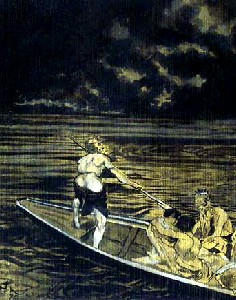
Dealing With the Deceased Menu: 1 2 3 4 5 6 <<First
Dealing With the Deceased in the Golden Age of Piracy, Page 6
Superstitions About Death
There are a variety of superstitions about the dead which have been associated with sailors. However, proof for many of these superstitions only appear in accounts written after the golden age of piracy. For example, Richard Henry Dana's 1840 account is the first source I found to support the idea that sailors had an "unwillingness to wear a dead man's clothes during the same voyage, and they seldom do so unless they are in absolute want."1
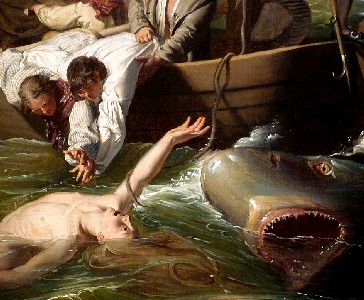
Artist: John Singleton Copley - Cabin boy Watson and the Shark (1777)
Another popular superstition mentioned in modern books about Age of Sail seamen concerns sharks following ships as harbingers of death. Charles Raymond Dillon, author of a variety of books on the supernatural, explains, “Seamen believed that sharks knew when death was coming to anyone on board ship. Sharks would follow a ship for miles waiting for a dead body to be consigned to the sea. A shark that persistently followed a ship was considered a death omen, and the fact was withheld from any sick seamen on board."2
Yet this is not supported by period accounts. Sharks are mentioned in conjunction with burial at sea in several narratives, but never as an omen of the death of the man. They usually only appear after the burial has taken place. Silas James noted that when one man died, they "threw him overboard, when a large shark descended after him, and, we supposed, swallowed the whole body."3 Francis Rogers similarly explained that the morning following the interment of their cook in the ocean, "10 or 12 sharks hankered about the ship for such another meal, they having met with the poor greasy cook."4
There are many other superstitions associated with death in modern books about sailors such as the idea that the ghosts of men buried at sea would return to haunt a vessel, a corpse needed a coin to pay Charon to row them across the river Styx and the belief that pirates and sailors wore earrings to pay for their funerals. Let's look at these in more detail.
1 Richard Henry Dana, Two Years Before the Mast, 1840, p. 48; 2 Charles Raymond Dillon, Superstitions and Folk Remedies, 2001, p. 62; 2 Silas Told, An Account of the Life, and Dealings of God with Silas Told &c., 1786, p. 12; 4 Francis Rogers, "The Journal of Francis Rogers", Three Sea Journals of Stuart Times, Bruce S. Ingram, editor, 1936, p. 163
Superstitions About The Death - Spirits, Ghosts and Omens
A superstition repeatedly mentioned by modern commentators about life at sea during the
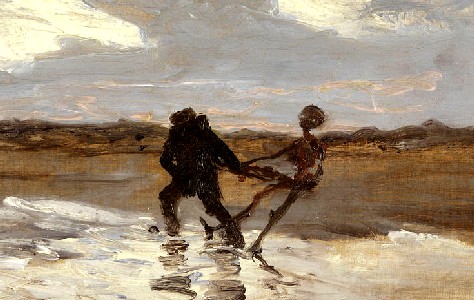
Artist: Thorvald Niss
Drowned Man's Ghost Tries to Claim a New Victim for the Sea (1932)
Age of Sail is that the ghosts of sailors buried at sea would haunt ships or bring them bad luck. Some of these myths were mentioned in previous sections, most involving the idea that if the corpse were kept around too long or allowed to see his former home (the ship) as he was being buried, he would return to haunt the ship.
However the connection made between sailors and ghosts presented in modern books is broader than that. Historian David Stewart says that it was believed that those killed in battle would return to haunt a ship, postulating two reasons for this: "their lives were cut short violently and they were not properly buried. Sailors abhorred the custom of throwing the dead overboard without burial rites."1
Stewart later explains, "To the maritime mind, the sea was alive with the spirits of unquiet dead, both on the surface and under the waves. Not all of these ghosts were malevolent, but all were feared. By performing the proper rites, sailors hoped to ensure that the dead would rest peacefully instead of returning to trouble the living."2
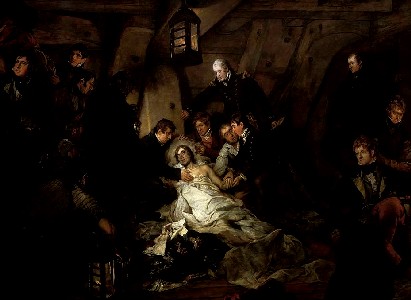
Artist: Arthur William Davis
Eerie Painting of the Death of Lord Nelson (1805)
By way of proof of the fear of being buried at sea and returning, Stewart cites Horation Nelson's plea not to be 'thrown overboard.' The first point of importance about this example with regard to this article is that Nelson died in 1805, long after the period of interest. In addition, nothing about the actual account even mentions the idea of spirits or ghosts. The surgeon on hand for Nelson's death, William Beatty, wrote the account,
HIS LORDSHIP had on several occasions told Captain HARDY, that if he should fall in battle in a foreign climate, he wished his body to be conveyed to England; and that if his Country should think proper to inter him at the public expence, he wished to be buried in Saint Paul's, as well as that his monument should be erected there. ...He also repeated to Captain HARDY several times during the last two years of his life: "Should I be killed, HARDY, and my Country not bury me, you know what to do with me;" meaning that his body was in that case to be laid by the side of his Father's, in his native village of Burnham Thorpe in Norfolk: and this, as has been before mentioned (in page 48), he adverted to in his last moments.3
This suggests a concern about having a permanent burial location if he were buried at sea. While Nelson might be accused of vanity, nothing from that account suggests he was superstitious.
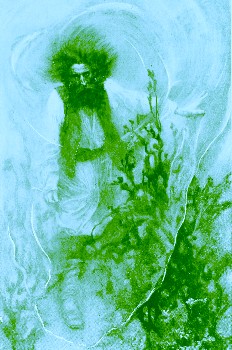
Artist: Howard Pyle
"There Cap'n Goldsack goes, creeping, creeping,
creeping, Looking for his treasure down below"
(1902)
This is not to say that superstitious men did not create a connection between specters and bodies buried without the proper ceremony; such an idea certainly did exist at sea. However the sea accounts from this time period do not support the idea that such a belief was more commonly held by superstitious sailors than it would be by a superstitious man on land. Writing several decades after the golden age of piracy about a shipwreck that took place in 1739, John Byron explained,
That common people in general are addicted to superstitious conceits, is an observation founded on experience; and the reason is evident: but I cannot allow that common seamen are more so than others of the lower class. In the most enlightened ages of antiquity, we find it to have been the popular opinion, that the spirits of the dead were not at rest till their bodies were interred; and that they did not cease to haunt and trouble those who had neglected this duty to the departed. This is still believed by the vulgar, in most countries4
Like Byron, some commentators present a division in belief between those inclined to believe in ghosts and those with a more rational outlook. A book written a couple decades before the golden age of piracy in 1639 called A Helpe to Memory and Discourse "asks whether 'doth a dead body in a shippe cause the shippe to sail slower, and if it doe, what is thought to be the reason thereof?' Answer: 'The shippe is as insensible of the living as of the dead, and as the living make it goe the faster, so the dead make
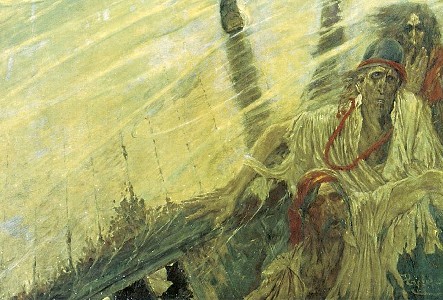
Artist: Howard Pyle - Crew of the Flying Dutchman (1900)
it not goe the slower, for the dead are no Rhemoras [remoras - obstacles] to alter the course of her passage, tho' some there be that thinke so, and that by a kind of mournful sympathy.'"5 Interestingly, this commentary does not dismiss the idea that the dead were hanging around, only that they would have any impact on the sailing ability of a ship.
There is one period account that discusses a ghost returning to haunt the living on a ship from the golden age of piracy. This comes from the account of the notably superstitious German Surgeon Johann Dietz who explains that after the corpse of the atheist carpenter was noticed floating behind the ship, "his ghost was repeatedly seen on board the vessel. This is a matter that I shall not discuss."6 Because the carpenter was an atheist, he did not have the customary prayers read over him upon burial, which may be the reason the men were particularly sensitive to his post-burial return.
Yet another account discussing a superstitious connection with a death found in Exquemelin's buccaneering book says that after Henry Shergall drowned "several of our company did interpret as a bad omen of the place; which proved not so"7. Exquemelin goes on to attribute the lack of bad luck to the grace of God, again suggesting that the prayers at sea may have kept the dead where they belonged.
1 David J. Stewart, The Sea Their Graves, 2011, p. 111; 2 Stewart, p. 115; 3 William Beatty, Authentic Narrative of the Death of Lord Nelson, 3rd ed, 1825, p. 75-6; 4 John Byron, The Narrative of the Honourable John Byron: Containing an Account of the Great Distresses Suffered by Himself and His Companions on the Coast of Patagonia from the Year 1740 Till Their Arrival in England 1746, 1768, p. 100-1;5 Johann Dietz, Master Johann Dietz, Surgeon in the Army of the Great Elector and Barber to the Royal Court, p. 148; 6 Alexandre Exquemelin, This History of the Buccaneers of America, 1856, p. 288
Superstitions About The Death - Charon's Boat
Photo: Daniel Villafruela
Roman Skull With Obol In Its Mouth, From
Museu
de Prehistoria de València
The dead were sometimes buried with a coin under their tongue which was intended to pay Charon. A 1703 dictionary entry for Charon explains the reasoning for this. "Charon, look’d upon by ancient Pagans to be a Ferry-man, to whom Souls were obliged to pay a certain piece of Mony, for their passage over the River Styx to Hell. And this, undoubtedly, was the Reason some people put a piece of Coin into their Friends Mouths when dead, that they might have wherewith to pay this imaginary Debt."1 This dates this practice to the golden age of piracy.
Charon was a Greek god who required the payment of a coin to convey souls across the river that divided the world of the living from that of the dead. From this grew the practice of placing a coin (an obol) in the corpse's mouth by the ancient Greeks and Romans. "Among the Greeks, coins in actual burials are sometimes also [in addition to the obol] a danakē (δανάκη) or other relatively small-denomination gold, silver, bronze or copper coin in local use. In Roman literary sources the coin is usually bronze or copper."2
Although there are no references to the placement of coins in the mouths of corpses who died on ships, sailor Francis Rogers does give a rather intriguing account of an encounter with what some on board his ship suspected was Charon's boat in the Caribbean during September of 1705. (I have inserted some paragraph breaks to make it more readable.)
Artist: Hans Thoma
Mythologische Szene, Charon's Boat (1876)
Mr. Nesbitt, one of the officers that came on board us at the Maderas, (was) taken light-headed all at once (as we were drinking a bowl of punch on the poop), with violent fever. At night, about 9 o’clock, quite calm, and clear moonlight night, as Mr. Pugh and I were standing talking on the deck, he asked me if I did not see a boat, pointing upon our star board side. At first I did not, but presently did (as I thought) very plain, and it seemed so near us, I was somewhat surprised not expecting a boat in the middle of the ocean, as it were. We stood sometime and gazed at it, being a very fine clear moonlight night, and thought it sometimes far from us, and then near us at once.Not knowing what to make of it, I went and waked Captain Kimber and told him there was a boat very near us. He was not ready to believe it, However, upon our assuring we were in earnest, he turned out to see it. When he came upon deck, he soon saw what we spoke of. He was much surprised, and it seeming sometimes very near us, he ordered up the small arms; the ship’s company being now alarum’d saw the same thing. The Captain began to think he might possibly be out of his reckoning, and that this might be an enemy’s boat from some part of Hispaniola. (He) made us stand to our arms, but yet loath to think himself so much deceived in his reckoning; being 200 leagues from any land by his account. We haled it several times, when it was near us, but no answer.

Artist: Arnold Böcklin - Rowing to the Isle of the Dead (1880)
Sometimes we imagined we saw the men rowing very plain and then again could not tell what to make of them, continuing thus near half an hour. Sometimes we thought it almost on board and then gone again of a sudden. I fired a pistol at it; it continued the same a very little while, and then we saw no more of our boat. Mr. Pugh would have it to be Charon’s boat for Mr. Nesbitt (who was then very ill), saying he believed he would die, as indeed he did, I think the next night. We, the next morning, spoke to the Brig and Sloop and asked them if they saw any boat. They said no, and wondered at what we told them, so we all concluded it was an apparition forerunning Mr. Nesbitt’s death, unless we could lay becalmed mounting upon a swell as we then had.
I cannot tell how to resolve within myself about it, not being very ready to credit the stories of apparitions, but such we thought it then. The day or 2 after, we throw’d overboard Mr. Nesbitt, firing some minute guns at his obsequies, he being and Ensign of --- regiment in Beau Sims company, designed for Antigoa. (The) Ship’s company now fall very sick, having a malignant and spotted fever very rife among us though (they) mostly recover. (Thank God I had my health very well.)3
1 "Charlotte of Bourbon – Chatri”, An universal, historical, geographical, chronological and poetical dictionary, exactly describing the situation, extent, customs ... of all kingdoms, 1703, not paginated; 2 Charon's obol, wikipedia.com, gathered 10/16/15; 3 Francis Rogers, "The Journal of Francis Rogers", Three Sea Journals of Stuart Times, Bruce S. Ingram, editor, 1936, p. 223-4
Superstitions About The Death - The Earring as Payment for a Funeral?
One of the rampant myths about pirates is that they wore an earring so that it could be cashed in and used to pay for their funeral. This appears on a variety of websites1 and modern books. One example explains, "I heard that the reason (or one of the reasons) sailors wore earrings was so that, should they drown and their body be washed ashore, the earring could be sold to pay for a funeral."2
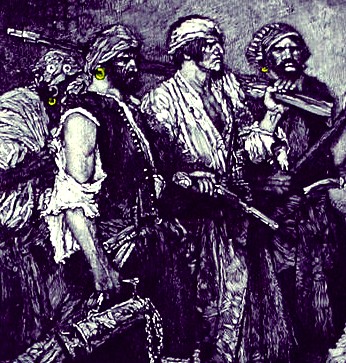
Artist: Howard Pyle
Earrings on Pirates, From The Sacking of Panama (1887)
In a discussion about the historical use of pirate earrings for such a purpose on the piratesinfo forum, researcher Tony Malesic pointed out, "If a pirate was captured and hanged, they were almost always unceremoniously buried in unhallowed ground (for example, in shallow, unmarked graves, next to the sea, between the high and low tide marks.) Pirates were forbidden to be buried in hallowed ground, such as a church graveyard. The cost of the unceremonious burials were paid for by the courts, so it didn't cost the deceased pirate in the end."3
Pirates were also noted for their profligate spending behavior and many would be unlikely to have the discipline to keep an earring against their burial. This is reflected in a speech attributed to pirate Bartholomew Roberts, In an honest Service, says he, there is thin Commons, low Wages, and hard Labour; in this [piracy], Plenty and Suriety, Pleasure and Ease, Liberty and Power; and who would not ballance Creditor on this Side, when all the Hazard that is run for it, at worst, is only four Look at two choaking. No, A merry Life and a short one, shall be my Motto."4
I searched Google books for the years 1600-1960 for a document containing 'earring' and 'funeral' to see if there were any references to the use of an earring to pay for a funeral. I found none. The earliest printed reference I can find for this concept is from 1991 in a book about women on Greek vases. There, the authors explain in an aside that pirates "wore a gold earring, not as a display of bravado, but as an insurance to provide funds for a decent funeral whereever they might die."5 (If anyone can find an earlier source for the notion, I would be happy to print it here and give you credit.)
In addition there is the greater question of whether the sale of an earring (or even a pair of them) would generate enough money to provide for even a simple burial. Based on the limited evidence that exists today, burial of unknown sailors seems to have been primarily undertaken by private individuals or local governments. For example, an unknown sailor being murdered in Surrey in 1786 was buried in the Thursley churchyard. Although it is not stated who paid for the funeral, "the general public paid for a special monument"6. Chatham, Massachusetts established a cemetery in 1846 for bodies of unknown sailors who washed up on shore because of shipwrecks in the area.7 While both of these examples post-date the golden age of piracy, it presents a more likely explanation of how the burial of unknown sailors was performed. Given that living shipwrecked sailors were typically treated with an extraordinary amount of charity by local citizens8, there is no reason to believe this charity would not extend to those who had perished as well.
Yet there is an even greater question to be considered which may completely eliminate the need to explain the reason for pirates wearing earrings.
1 There are multiple examples of this as a lot of websites tend to copy each other without looking into the source of the information. For examples, see: Remy Melina, "Why Did Pirates Wear Earrings?" livescience.com; Nikki Marie Oliveira, "Why Pirates Wore Earrings", margolis.com; User Silver Steele, "Earrings? Help settle an argument", Piracy.com Forums; all gathered 10/16/15; 2 Barbarahamse, "Question on sailors and earrings," wikipedia.org, gathered 10/16/15; 3 Tony Malesic, quoted by the author in the thread "Earrings?" dated 8/12/2004, piratesinfo.com, gathered 10/12/15; 4 Captain Charles Johnson, A general history of the pirates, 3rd Edition, p. 272-3; 5 Peter Evans & Lyle Eveille, Symposia and women on Greek vases : a filmstrip with commentary, 1992, p. 49; 6 "Facelift for sailor murder memorial stone", getSurrey.com, originally published 14 May 2009, gathered 10/17/15; 7 See "Chatham, Massachusetts", familysearch.org, gathered 10/17/15 & "9. Unknown Sailor's Cemetary", eTourChatham.org, gathered 10/17/15; 8 For some period and near-period examples, see Silas Told, An Account of the Life, and Dealings of God with Silas Told &c., 1786, p. 35-47 & Jonathan Dickinson, Jonathan Dickinson's Journal or God's Protecting Providence
Did Pirate Wear Earrings?
Perhaps the more salient question is whether pirates or even sailors generally wore earrings during the golden age of piracy at all. A search through the period sea accounts from this time for a relationship between earrings and sailors turned up only references to their value as treasure.1
In the entry on earrings in his Pirates! An A-Z Encyclopedia, historian Jan Rogozinski categorically denies earrings were worn by pirates during this time, referring to them as a 'fictional pirate ornament'.
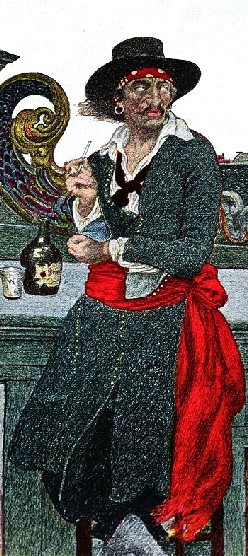
Artist: Howard Pyle
Kidd on the Deck of the Adventure Galley
(From before 1911)
Caribbean pirates sometimes are shown wearing one or two brass or gold "Gypsy" hoops. In real life, European men wore earrings -but not hoops- only during the 16th century. Even women's earrings disappeared during later eras, when long hair, wigs or headresses obscured the ears.
As hair styles became shorter during the 1500s, Spanish and English aristocrats sometimes sported earrings. The fad affected only court nobles, who displayed pearls and other jewels and not metal hoops. Sir Walter Raleigh, Sir Francis Drake, the earl of Cumberland and Sir Anthony Sherley may have worn earrings at court, but they left them at home during voyages. In France, earrings briefly became fashionable under the homosexual King Henry III (1551-1589).
Earrings vanished during the 1600s, as aristocrats again adopted shoulder-length hair styles. In England, male earrings, unthinkable under the Puritans, were not restored with the monarchy in 1660.
The origins of the hoop earring myth are obscure. There are no earrings in Exquemelin (1678) and Daniel Defoe's General History (1724-1728). Earrings also are absent from 19th-century fiction, such as the Pirates Own Book (1837), Treasure Island (1883), and Peter Pan (1904). Howard Pyle was the first major author to put earrings in text and illustrations. His pirates sometimes flaunt silver and jeweled pendants rather than gypsy hoops.2
In fact, Rogozinski has that last point wrong; several of Pyle's drawing show them sporting pretty sizeable hoop earrings, dating as far back as 1887 (see the image in the previous section). Still, Pyle is the most likely source of the pirate-earring connection. Hollywood is known to have copied his stylized works in their movies.
Some images have been presented as proof that pirates, or at least sailors, wore earrings during this era. (Note that I am excluding
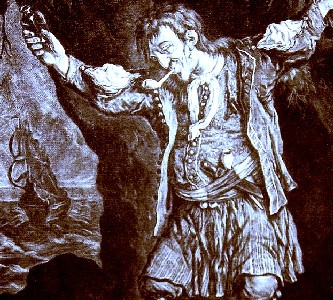
Artist: Cornelus Dusart
Dutch Sailor with a Pendant Earring, British Museum (1675-1704)
images from outside of the 1690 - 1725 time frame. Earlier era privateers and pirates such as Sir Francis Drake and Sir Walter Raleigh are sometimes shown wearing pendant earrings because they were fashionable in the 16th century as the Rogozinski quote indicates in the previous section.)
There are a few images of Dutch sailors wearing earrings from the late 17th century such as the one by by Cornelus Dusart seen at left. This image is strikingly similar to another work by Dusart, "The Sailor to the East Indies Dancing with his Mistress" which dates to about the same time.
However, as pirate historian Ed Fox pointed in an on-line discussion about such images, the pictured sailor is Dutch. Ed notes, "I know of no evidence for Anglo-American sailors, 1690-1730 [the golden age of piracy as he defines it], or indeed pirates of the same period, wearing earrings. ...So no, we can't say that no pirate of the period sported an earring, but we can say for absolute and definite that they weren't common in any way"3.
Another common point raised by those wishing to prove earrings were worn by pirates is the flag attributed to pirate Henry Every (seen below left). However, according to Dr. Fox, this flag design is modern. "As far as I can tell, after years of hunting, the 'Every' flag first appeared in Douglas Botting's Time Life book, 'Pirates', in 1978."4 He explains in this book "Henry Every's career ended before the age of the jolly roger really began, and there is no record of Every flying a black flag."5
There is a period image showing Every flying a black flag from the 1725 edition of Charles Johnson's A General History of the Pirates (see below right). Although they are from the period, the images found in the Johnson's were created by men who had to rely on the descriptions from the book without having seen the men or situations they were drawing. This may explain why Every is shown with a black flag even though Dr. Fox says there is no corresponding description in the book. Even so, the 1725 flag shows only crossed bones, a feature mentioned in several of Johnson's accounts. It does not show the side portrait with the scarf and earring.
 The Alleged Henry Every Flag (20th Century) |
Every, From General History of the Pirates (1725) |
Based on the information we have from the time, it appears unlikely that most sailors or pirates wore earrings, with the exception of some Dutch shown wearing pendant earrings. If pirates did not generally wearing earrings, the need to determine whether they were used as a means for financing their funeral becomes irrelevant.
1 For examples, see Francis Rogers, "The Journal of Francis Rogers", Three Sea Journals of Stuart Times, Bruce S. Ingram, editor, 1936, p. 206-7 and Woodes Rogers, A Cruizing Voyage round the World, 1712, p. 234; 2 Jan Rogozinski, Pirates! And A-Z Encyclopedia, 1996, p. 110; 3 Ed Fox, "An Earring for your perusal", piracy pub, gathered 10/1/15; 4 Message discussion with Ed Fox, 10/15/15; 5 E.T. Fox, Jolly Rogers, the True History of Pirate Flags, 2015, p. 16

